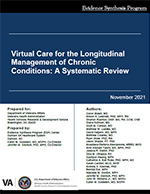
|
Prepared by: Recommended citation: |
Download PDF: Complete Report, Executive Summary, Report, Appendices
Providing health care via video or telephone is frequently being used to replace in-person clinic visits for managing chronic conditions. However, there is next to no evidence supporting this practice for the most common chronic conditions such as diabetes, heart failure, and COPD. Evidence is needed to guide optimal use of virtual care as a substitute for in-person care, for which patients, for which conditions, and at what risk.
Virtual health care facilitates interactions between patients and clinicians across a physical distance and may address temporal, geographical, physical, and social barriers to obtaining health care. The COVID-19 pandemic led to an unprecedented growth in synchronous virtual care via phone and video. Our systematic review examined the use of synchronous virtual care as a substitute for in-person care in the context of chronic management for CHF, COPD, and T2DM.
We found scant literature evaluating the effect of synchronous virtual care delivered by a prescribing clinician as a substitute for in-person care for chronic disease management of common conditions, namely T2DM, COPD, and CHF (4 in T2DM and 1 in CHF). Among the included studies, there was significant heterogeneity around the structure, purpose, and delivery of virtual care visits. While not statistically significant and with very low certainty of the evidence, our analysis suggested a trend toward greater A1c reduction among virtual care interventions vs comparators or at least no difference. Note that these studies did not employ non-inferiority analytic approaches. The clinical significance of this finding is unknown. In addition, the generalizability of these findings is limited as all included studies took place in specialty care clinics while much of the long-term management for these chronic conditions occurs within the context of primary care.
Systematic Review: Virtual Care for the Longitudinal Management of Chronic Conditions - Management eBrief
Lewinski A, Walsh C, Rushton S, et al. Telehealth for the Longitudinal Management of Chronic Conditions: Systematic Review. Journal of Medical Internet Research. 2022;24(8):e37100. DOI: 10.2196/37100